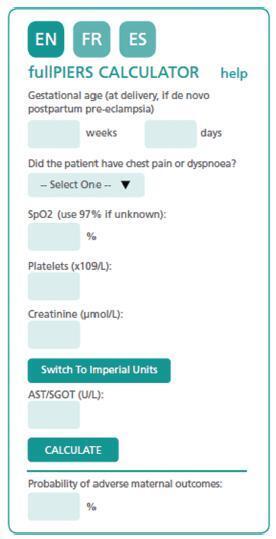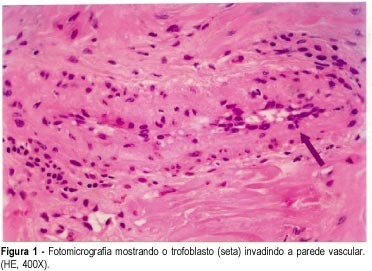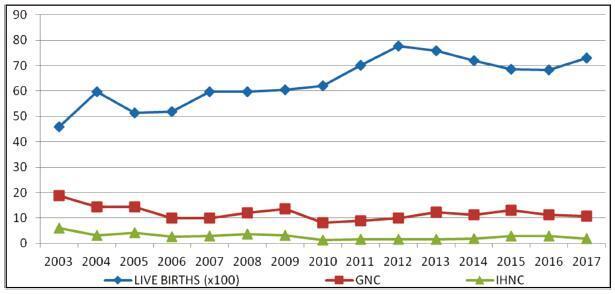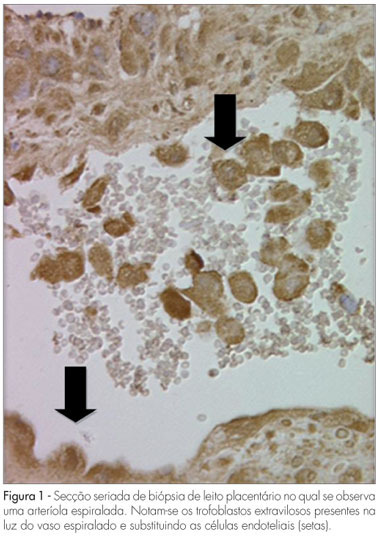You searched for:"Nelson Sass"
We found (20) results for your search.Summary
Rev Bras Ginecol Obstet. 2010;32(7):346-351
DOI 10.1590/S0100-72032010000700007
PURPOSE: to compare the effectiveness of the Foley balloon with vaginal misoprostol for cervical ripening and labor induction. METHODS: randomized clinical trial, not blind, conducted from January 2006 to January 2008. A total of 160 pregnant women with indication for induction of labor were included and divided into two groups, 80 for Foley and 80 for vaginal misoprostol. Inclusion criteria were: gestational age of 37 weeks or more, a live single fetus with cephalic presentation and a Bishop score of four or less. We excluded patients with a uterine scar, ruptured membranes, estimated fetal weight greater than 4000 g, placenta previa, chorioamnionitis and conditions that imposed the immediate termination of pregnancy. Statistical tests employed were Mann-Whitney, χ2 test or Fisher's exact test, and p value was significant if less than 0.005. RESULTS: misoprostol triggered more frequently spontaneous delivery (50.0 versus 15.0% for Foley, p<0.001) and required less use of oxytocin (41.2 versus 76.2%), and this group presented more tachysystole (21.2 versus 5.0%). The Foley catheter caused more discomfort to the patient (28.7 versus 1.2%). There were no differences in the time required for development of the Bishop score (20.69 versus 21.36 hours), for triggering delivery (36.42 versus 29.57 hours) or in rates of cesarean delivery (51.2 versus 42.5%). There were no significant differences in perinatal performance, with similar rates of abnormal cardiotocography (20.0 versus 21.2%), presence of meconium (13.7 versus 17.5%) and need for neonatal intensive care unit (3.7 versus 6.2%). CONCLUSIONS: the use of the Foley catheter was as effective as misoprostol for cervical ripening, but less effective in triggering spontaneous labor. Our results support the recommendation of its use for cervical ripening, especially in patients with cesarean scar.
Summary
Rev Bras Ginecol Obstet. 2010;32(8):398-404
DOI 10.1590/S0100-72032010000800007
PURPOSE: to evaluate the characteristics regarding care of Bolivian pregnant women and their outcomes in Hospital Municipal Vereador José Storopolli. METHODS: a cross-sectional retrospective case-control study comparing two groups of pregnant women from 2003 to 2007. The Study Group included 312 Bolivian pregnant women and the Control Group, 314 Brazilian women. The groups were compared with respect to demographic variables, the presence of maternal complications and perinatal outcomes. Statistical analysis was performed by χ2 test and, when necessary, by applying Yates' correction. RESULTS: compared to Brazilian mothers, a smaller number of Bolivian women received prenatal care (16.4 versus 5.1%, p<0.001) and among those that did, the percentage of those who had less than five visits was higher (50 versus 19.3%, p<0.001). Compared to the Brazilian group, the Bolivian group had fewer unwed mothers (12.1 versus 25.4%, p<0.001) and a lower number of nulliparous women (34.1 versus 43.6%, p=0.017). Congenital syphilis had a higher incidence in the Bolivian group (2.9 versus 0.5%, p<0.05), as well as a higher number of newborns classified as large for gestational age (14.6 versus 5.8%, p <0.001). CONCLUSIONS: the failure to attend prenatal care or its completion with an inadequate number of consultations, and the higher number of cases of congenital syphilis observed among the Bolivian women show the great vulnerability of this ethnic minority group to health problems. Consequently, it is necessary a strategic planning of the sectors responsible for coordinating assistance in our country, in order to reduce this disparity, either through socio-economic improvements or by the implementation of health care tailored to the needs of this group.
Summary
Rev Bras Ginecol Obstet. 2017;39(9):496-512
The authors review hypertensive disease during pregnancy with an academic and practical view, and using the best evidence available. This disease, which is the most important clinical disease in Brazilian pregnant women, may have its incidence reduced with prevention through the use of calcium and aspirin in pregnant women at risk. Previously, it was a disease that presented with hypertension with proteinuria, but it has now been classified with new clinical parameters besides proteinuria. Morbidity and mortality should be reduced in a continental country such as Brazil using protocols for the early treatment of complications by calculating severe outcomes in preeclampsia. The early treatment of acute hypertension, use of magnesium sulfate and early hospitalization in cases of preeclampsia are concepts to pursue the reduction of our pregnant women’s mortality.

Summary
Rev Bras Ginecol Obstet. 2003;25(8):585-591
DOI 10.1590/S0100-72032003000800007
PURPOSE: to analyze the histopathological patterns of the placental bed arteries in pregnancies complicated by abruptio placentae (AP) and compare them with the normal vascular histology of the placental bed. METHODS: placental bed biopsy was performed in 23 pregnant women with a diagnosis of abruptio placentae associated with high blood pressure (G/HBP) disorders, with gestational age of 28 weeks or more, submitted to cesarean section. The control group (CG) consisted of 30 patients without disease, submitted to cesarean section for obstetric reasons. The selected histological variables were: unaltered pattern, physiological changes, medial layer disorganization, hyperplastic changes, acute necrosis and atherosis. RESULTS: in patients with AP associated with HBP there was a significant predominance of medial layer disorganization and hyperplastic changes, compared to CG, while physiological changes in spiral arteries were statistically more common in CG. Findings of acute necrosis and atherosis were observed in a low number of G/HBP, with no statistical significance. CONCLUSIONS: in pregnant women with AP associated with HBP the predominant vascular histological findings were medial layer disorganization and hyperplastic changes. The presence of histopathological features was significantly higher in G/HBP, with prevalence of medial layer disorganization. Normal histological pattern, i.e., physiological changes, were more prevalent in CG.

Summary
Rev Bras Ginecol Obstet. 2020;42(9):586-587
Summary
Rev Bras Ginecol Obstet. 2019;41(10):597-606
To evaluate conditions associated with stillbirth (SB), and possible trends related with it, in a maternity hospital school in the North zone of São Paulo.
An observational, cross-sectional study conducted at the Hospital Maternidade- escola de Vila Nova Cachoeirinha with 1,139 SBs in the period of 2003 to 2017. Cases of intermediate SB (ISB) (weight between 500 and 999 g) and late SB (LSB) (weight ≥ 1,000 g) were compared. We evaluated clinical data, laboratory tests, and fetal and placental studies. Data were stored in Windows Excel (Microsoft Corp., Redmond, WA, USA) worksheets, according to which graphs and tables were constructed. We used the statistical software SPSS for Windows version 18.0 (SPSS In., Chicago, IL, USA), estimating the prevalence ratio (PR) and odds ratio (OR), considering the 95% confidence interval (95% CI).
The general SB rate was 11.9%, and the in-hospital SB rate was 2.8%. Pregnant women younger than 16 years of age were more likely to have ISB (OR 0.32, 0.15- 0.76), while patients older than 40 years old had a higher chance of LSB (PR 0.85, 0.72- 0.99). A total of 25.7% of the general population did not have prenatal care, and 77.1% of the cases presented fetal death at admission. The cases of ISB had a statistically significant association with home birth (OR 0.61, 0.46-0.80). Cesarean section was performed in 16.1% of the subjects, and misoprostol was the most used method for induction. Necropsy and placental study of the fetuses were performed, respectively, in 94.2% and 97.3% of the cases. Associated causes were not identified in 22.1% of the cases, and the main causes identified were amniotic sac infections (27.9%), fetal malformations (12.5%), placental abruption (11.2%), hypertensive syndromes (8.5%), and maternal syphilis (3.9%), the latter with an increasing trend.
Among the factors associated to SB were: hypertensive syndromes, amniotic sac infections, fetal malformations, placental abruption and syphilis. There was a growing trend in the number of cases of syphilis, which translates an alert. Diagnostic limitations justify indeterminate causes.

Summary
Rev Bras Ginecol Obstet. 2010;32(12):609-616
DOI 10.1590/S0100-72032010001200008
Preeclampsia is a systemic syndrome characterized by inflammatory and antiangiogenic states. The pathogenesis of preeclampsia involves deficient trophoblast invasion that is responsible for altered uterine blood flow and placental oxidative stress. The damaged placenta produces higher concentrations of sFlt-1, a soluble receptor for VEGF and PlGF that is released in the maternal circulation and is involved in endothelial dysfunction. Actually, all processes involved in inflammation, endothelial dysfunction and oxidative stress are strongly correlated and act in a synergistic way. Recent data have shown that an increase in serum concentrations of sFlt-1 initiates 5 to 6 weeks before the clinical manifestations of preeclampsia and these alterations correlate with a decrease in serum concentrations of PlGF. Therefore, both sFlt-1 and PlGF have been suggested to be useful for an early-diagnosis of preeclampsia. The knowledge about the role of antiangiogenic factors in the pathogenesis of preeclampsia has raised the possibility of a therapy involving these factors.In this article we revisited the pathogenesis of preeclampsia addressing its antiangiogenic and inflammatory states.In conclusion, we correlated these alterations with the higher risk for cardiovascular diseases presented by these women in future life.

Summary
Rev Bras Ginecol Obstet. 2021;43(1):61-65
Pre-eclampsia (PE) is a severe disorder that affects up to 8% of all pregnancies and represents an important cause of maternal and perinatal morbidity and mortality. The screening of the disease is a subject of studies, but the complexity and uncertainties regarding its etiology make this objective a difficult task. In addition, the costs related to screening protocols, the heterogeneity of the most affected populations and the lack of highly effective prevention methods reduce the potential of current available algorithms for screening. Thus, the National Specialized Commission of Hypertension in Pregnancy of the Brazilian Association of Gynecology and Obstetrics Federation (Febrasgo, in the Portuguese acronym) (NSC Hypertension in Pregnancy of the Febrasgo) considers that there are no screening algorithms to be implemented in the country to date and advocates that Aspirin and calcium should be widely used.